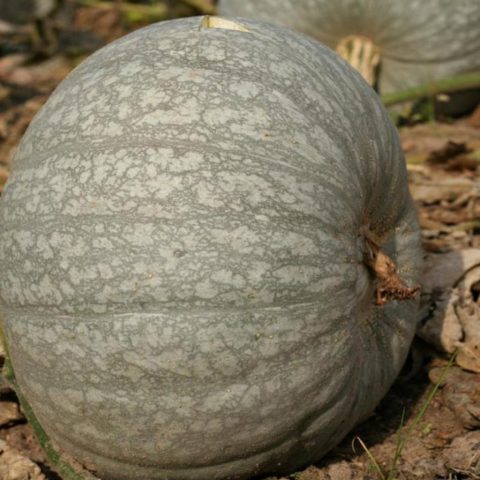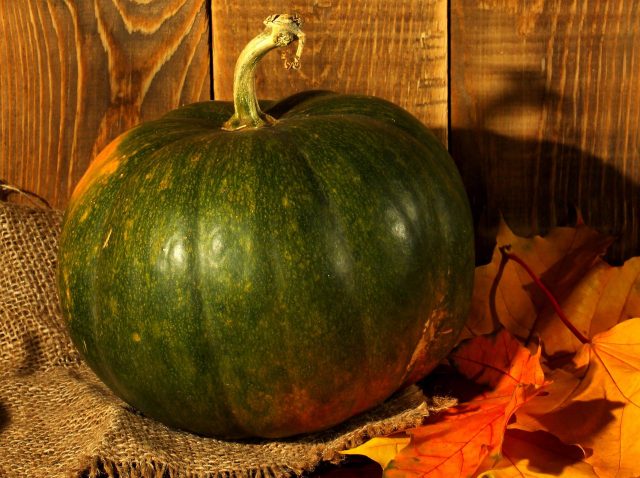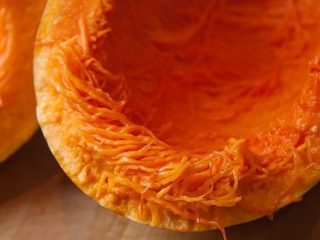Content
Gymnosperm pumpkin does not differ in appearance from ordinary pumpkin and is not a separate subtype of the crop. Their agricultural technology is similar; the method of cultivation does not differ. The main advantage of gymnosperm species is that the seeds are not covered with a hard shell, which makes them more convenient to process.
General description of gymnosperm pumpkin
The gymnosperm pumpkin (pictured) has no visual difference from the ordinary pumpkin. This herbaceous plant with intensive growth and shoot formation can cover an area of up to 30 m in 2-4 months. The crop is represented by a variety of varieties, differing in color and shape of the fruit. The basic requirements for growing conditions for gymnosperm and classic pumpkins are the same.
The biological characteristics of gymnosperm and ordinary pumpkin do not differ. Depending on the variety, the crop ripens at approximately the same time. Gymnosperms are more sensitive to soil temperature during planting. Seeds unprotected by the shell germinate faster, but if the soil temperature is below +17 0C, sprouts may die.An ordinary pumpkin is planted with seeds directly into the soil; gymnosperms are recommended to be grown using seedlings.
Gymnosperm pumpkin varieties do not produce large fruits; the average weight is from 6 to 8 kg. It produces more flowers than the classic species; they are larger in size. General description of gymnosperm pumpkin:
- The vines are hollow, long (up to 8 m), thick, some varieties require the formation of a bush by removing excess shoots. Stems are light green, ribbed, finely pubescent. The mustache is long and medium in size.
- The foliage is intense, the leaves are opposite, round, five-lobed, slightly dissected. The surface is smooth with thick veins, dark green, pubescent.
- On average, a pumpkin produces 70 female flowers and more than 350 male flowers, the male ones appear first, then the female ones grow at the 4-8th internodes. The flowers are simple, solitary, bright yellow.
- The shape of the fruit and the weight depend on the variety; they are mainly round pumpkins with an orange color and dark green vertical stripes.
- The medium-sized seeds are covered with a thin dark green film, are formed in large quantities, and are located in deep seed chambers.
The benefits and harms of gymnosperm pumpkin
The chemical composition of the fruits contains many useful elements, so they are widely used in traditional medicine recipes and the pharmacological industry. Gymnosperm pumpkin is no different in pulp composition from regular pumpkin. The seeds are useful in the fight against helminths. The substance cucurbitin is contained in the film between the seed and the hard shell; in a regular pumpkin the film is thin.Cucurbitin is a green substance; in gymnosperms the film is much thicker, so the concentration of the substance is higher.
Beneficial features:
- Vitamins PP, B5, B1, E, B9 are involved in the metabolism of proteins, fats and carbohydrates, and provide the body with energy. They synthesize hemoglobin, promote the production of amino acids, normalize the absorption function of the intestine, and improve the functioning of the adrenal glands.
- Thanks to choline, pumpkin has hepatoprotective properties. The substance is part of lecithin, participates in phospholipid metabolism, generates liver tissue.
- Phosphorus and zinc improve the condition of the walls of blood vessels, give them elasticity, and stop the formation of blood clots. They prevent the development of prostatitis and adenoma, zinc stimulates the production of testosterone and estrogen.
- Calcium helps strengthen bone tissue.
- Amino acids improve brain activity.
- Pumpkin has diuretic and choleretic properties, prevents the formation of stones in the bladder and ducts.
- Iron is involved in hematopoiesis.
- Omega-3 and Omega-6 fats moisturize the skin and have antioxidant properties. Together with vitamins, they normalize hormonal levels, thereby eliminating acne.
- The seeds are used for helminthiasis caused by pinworms, tapeworms, and bovine tapeworms.
The benefits of the seeds and pulp of gymnosperm pumpkin are beyond doubt; possible harm is caused to the body if consumed excessively:
- in people with dysbacteriosis, defecation may be impaired;
- in some cases, an allergic reaction to pumpkin occurs;
- People with diabetes are not recommended to indulge in pumpkin seeds;
- in people with acid-base imbalance, the condition may worsen.
Varieties of gymnosperm pumpkin
The gymnosperm variety of the crop was created to simplify the technology of processing seeds into oil. Later, varieties with improved gastronomic qualities were developed. A general overview of popular varieties of gymnosperm pumpkin and their names will help you decide on the choice of seeds for planting.
Styrian
Styrian gymnosperm pumpkin (Austrian) comes from the Austrian province of the same name. Created for the food industry, Styrian gymnosperm pumpkin seeds contain a high concentration of oils. The culture is adapted to the weather conditions of Russia. They are grown on an industrial scale and in private plots. Pulp with a low sugar content and a subtle nutty odor.
Characteristics of Styrian gymnosperm pumpkin:
- medium late, ripens in 3 months;
- heat-loving, demanding on lighting;
- long stems, bush with high shoot formation;
- the fruits are round in shape, weighing 5-7 kg, the main color is green with light yellow lines.
- forms a large number of medium-sized seeds, dark green in color.
Shelf life – 3 months.
Apricot
Apricot gymnosperm pumpkin belongs to dessert varieties, created on the basis of Styrian; according to reviews, the varieties are similar in appearance. The surface of the fruit is bright yellow with green longitudinal stripes. It got its name from the taste of its beige pulp. The taste is sweet, rich, with notes of apricot. The seeds are medium, in large quantities. Advantages of the Apricot gymnosperm pumpkin: taste and chemical composition of the seeds. In the USSR, the crop was grown for the production of apricot juice.The variety is medium late, with intensive weaving, weight – up to 8 kg.
Gymnosemyanka
The biological characteristics of Golosemyanka pumpkin do not differ from other varieties of Austrian selection. The bush plant is adapted to a temperate climate; the crop is grown for technical purposes, to obtain oil. This is one of the first representatives of gymnosperm varieties to appear in Russia.
Description of the variety and characteristics of Golosemyanka pumpkin:
- medium-late, fruits reach biological ripeness in 110 days;
- forms a small number of lashes, branched shoots, up to 4 m long;
- the fruits are slightly flattened at the top and base, yellow and green in color, with a lack of light the green color dominates;
- the pulp is light yellow, slightly fibrous;
- taste neutral or slightly sweet;
It produces a lot of seeds, they have a dark gray tint.
Danae
According to reviews, the gymnospermous pumpkin Danae is the most popular in the Middle Zone. A culture was created in Rostov for technical cultivation. Description of pumpkin:
- frost-resistant, does not stop growing when the temperature drops;
- medium-late, growing season 120 days;
- highly branched bush with medium shoot formation;
- fruits are round, dark green, with a mesh pattern;
- the pulp is light yellow, unsweetened, fibrous;
- produces many large oilseeds. Sensitive to cross-pollination.
Olga
Olga is an early ripening gymnosperm pumpkin. Created for table use. The culture is semi-bush, compact, short vines. Fruit ripening is simultaneous, pumpkins are aligned, weighing 1.5-3 kg. The pulp is juicy, sweet, low-fiber, rich yellow. The peel is hard, thin, the surface is orange with a light segment.The seeds are small, light green, and are formed in small quantities.
Juno
The gymnosperm pumpkin Juno is an early ripening pumpkin, because it ripens in 90 days. He is an unpretentious representative of culture. This is the only drought-resistant gymnosperm variety. The plant is spreading, intensively forms side shoots, the stems are long, unlimited in growth. Does not tolerate dense planting and dense crown. Requires bush formation. The crop is high-yielding, the fruits are evenly shaped and have a standard color for gymnospermous varieties. Weight of pumpkins is up to 8 kg. The coating of the seeds is dark, closer to black, and many seeds are formed.
Miranda
Miranda is a gymnosperm representative of the Polish selection, a semi-bush, low-growing plant. The bush is not spreading, compact, and does not take up much space on the site. Description of the variety:
- medium late (105-110 days);
- shoot formation is weak;
- productivity is high;
- table variety;
- fruits are round, flattened, green at the stage of technical ripeness, when ripe they turn gray with a marble pattern, weight - 5-8 kg;
- the pulp is juicy, up to 7 cm thick, with a high content of starch and sugars;
- produces few light green seeds.
Eso
The copyright holder of the gymnosperm variety is the Czech company SEMO, a leading supplier of seeds on the European market. The variety was created for industrial cultivation. Fully adapted to Russian weather conditions. Gymnosperm pumpkin of this variety is a mid-season crop; 110 days are enough for complete ripening. The plant is climbing and occupies large areas. Grown only for seeds. The pulp is neutral in taste, thin, light yellow.The fruits are round, dark green, with a slight yellow splash, weighing up to 9 kg. The peel is hard and thin. Pumpkin can be stored for up to 1.5 months. After harvesting, the fruits are immediately processed.
Growing gymnosperm pumpkin
Gymnosperm pumpkin is a light-loving crop; it prefers areas open to the sun, protected from the north wind. The best growing option is on a hill on the south side. Drought resistance in gymnosperm varieties is low; plants require constant watering for vegetation. The root system is superficial, so waterlogging of the soil can lead to disease, or in the worst case, the death of the plant.
The required soil composition for the crop is neutral or slightly alkaline; gymnosperm pumpkin will not produce a harvest on acidic soil. The soil should be light, aerated, drained, fertile. So that nitrogen, potassium and phosphorus are in the required quantities. They replenish the supply with the help of fertilizing and crop rotation. Gymnosperm pumpkins have not been planted in one area for more than 3 years; the soil after growing melons and melons will not be suitable.
Distribute vegetables on the site in such a way that there is no ordinary pumpkin next to gymnosperm varieties. Plants are cross-pollinated; next year's planting material will not produce the desired variety. The bed is prepared before planting: it is dug up and organic matter is added. Moisten before sowing. The timing of seed planting is different for each climate zone. A prerequisite is that the soil warms up to +17 0C, and there was no threat of frost. The seeds germinate on the seventh day; if frost occurs at this moment, the plant no longer recovers.
Planting work:
- The seeds are heated for 8 hours at a temperature not exceeding +40 0C.
- Then placed for 5 hours in a solution of the drug “Vympel”.
- Make depressions measuring 30x30 cm, fill them with a solution of ash (100 g) and potassium sulfate (100 g) based on 2 waters.
- Mix humus (5 kg) with superphosphate (100 g), place it on the bottom of the hole, you should get a layer of about 15 cm.
- Plant 4 seeds at a depth of 5 cm, maintaining a distance of 4 cm between seeds.
- Cover with soil and mulch with straw or sawdust.
Direct planting in the ground is used in the southern regions. For temperate climates, in order to speed up the ripening time, seedlings are pre-grown. Gymnosperm pumpkin does not respond well to transplantation, so the seeds are sown in peat cups.
Growing seedlings:
- When sowing seeds, they are guided by weather conditions; seedlings will be ready for planting in 1 month.
- Soil consisting of peat, compost and topsoil in equal parts is poured into glasses.
- Plant the seeds at a depth of 4 cm.
- Pumpkin is grown at a temperature of 22 0C, creating illumination for 16 hours a day.
- When leaves appear, the seedlings are fed with Uniflor Rost.
Before placing them in the garden bed, take the seedlings out into the fresh air for several hours.
Sowing seeds and planting seedlings is carried out according to the same scheme. Row spacing is 70 cm, if the variety is bushy, then between plants - 65 cm, medium-climbing - 1.5 m, with intensive shoot formation - 2 m.
Gymnosperm pumpkin care:
- Water every evening at the root.
- Weeding and loosening as necessary.
- Feeding with Uniflor-micro, Azofoska, organic preparations.
- The side shoots are removed, from 4 to 7 ovaries are left on the bush, depending on the variety, and the tops are broken off.
When the fruits begin to ripen, they need to be placed on a layer of straw so that they do not come into contact with the ground or tied to a support.
Pests and diseases
Gymnosperm pumpkin varieties are selective, created by selecting high-quality planting material, so the crop has stable immunity. The most common diseases are powdery mildew and anthracnose.
Powdery mildew is a fungal disease that appears as gray spots on the leaves. The cause is excess nitrogen, lack of moisture, cold damp weather. Fighting methods:
- removal of problem areas;
- treatment of gymnosperm pumpkin with sodium phosphate or colloidal sulfur;
- using the drug “Topaz” or “Universal dew”.
The first signs of anthracnose are the appearance of dark yellow spots; over time they increase in size and become dark pink. The fungus completely infects the gymnospermous pumpkin, making the fruit unsuitable for consumption. If the plant is infected, it cannot be saved; the bush is completely removed from the site. Preventive action:
- compliance with crop rotation;
- disinfection of planting material with antifungal agents;
- treating the beds with a fungicide before planting;
- removing pumpkin residues and weed after collection from the site.
Aphids parasitize pumpkins; get rid of the pest with Iskra and Fitoverm. The Whitefly moth is less common; caterpillars are destroyed with the Commander.
Harvest and storage
A sign that the gymnosperm pumpkin is ripe is the rich color of the fruit and a dry stalk. Harvest dates depend on the variety and region of growth. Basically, this is autumn - mid-September for temperate climates, in the South - early October. Collect the pumpkin along with the stalk.Gymnospermous varieties do not have a long shelf life; the fruits begin to rot and the seeds inside germinate. The average shelf life is 60 days, Styrian gymnosperm is stored 1 month longer.
Conditions for storing pumpkin:
- dark room with a temperature no higher than +10 0C;
- air humidity – up to 80%;
- the fruits are placed on a hill (cannot be stored on the ground), covered with straw so that they do not touch each other;
- are reviewed periodically.
If signs of rotting appear, the gymnosperm pumpkin must be removed from storage, damaged areas removed and processed.
Conclusion
Gymnosperm pumpkin is a variety of ordinary pumpkin, mid-season, light-loving, with low drought resistance. The plant is cultivated for its seeds, which are used in the food industry. They do not have a top hard layer, which is economically beneficial during the processing process.


















